Themed collection Single-Crystal-to-Single-Crystal Transformations

Single-crystal-to-single-crystal transformations
Welcome to this CrystEngComm themed issue entitled “Single-Crystal-to-Single-Crystal Transformations”.

CrystEngComm, 2015,17, 8775-8775
https://doi.org/10.1039/C5CE90202A
Crystal structure analysis of molecular dynamics using synchrotron X-rays
X-ray crystallography using synchrotron X-rays enables observation of molecular dynamics in a crystal.
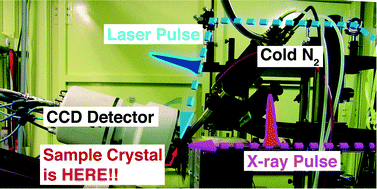
CrystEngComm, 2015,17, 8786-8795
https://doi.org/10.1039/C5CE01128K
Water-induced reversible SCSC or solid-state structural transformation in coordination polymers
In this highlight, we have focused our attention on several examples of coordination polymers (CPs) and metal–organic frameworks (MOFs) that exhibit water-induced reversible SCSC or solid-state structural transformations under thermal conditions.

CrystEngComm, 2015,17, 8776-8785
https://doi.org/10.1039/C5CE00530B
A single-crystal to single-crystal phase transition in [Co(NH3)5NO2]Br2 at high pressure: a step towards understanding linkage photo-isomerisation
A single-crystal to single-crystal phase transition above 6.0 GPa is discussed in relation to the structural mechanism of homogeneous linkage photoisomerisation that is accompanied by photomechanical effects in the same compound.
![Graphical abstract: A single-crystal to single-crystal phase transition in [Co(NH3)5NO2]Br2 at high pressure: a step towards understanding linkage photo-isomerisation](/en/Image/Get?imageInfo.ImageType=GA&imageInfo.ImageIdentifier.ManuscriptID=C5CE01820J&imageInfo.ImageIdentifier.Year=2015)
CrystEngComm, 2015,17, 8812-8816
https://doi.org/10.1039/C5CE01820J
Solvent-induced single-crystal to single-crystal transformation of a Zn4O-containing doubly interpenetrated metal–organic framework with a pcu net
A present metal–organic framework with an interpenetrating pcu net showed the structural change in single-crystal to single-crystal manner upon guest-exchange.
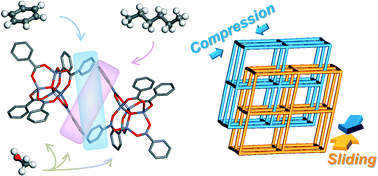
CrystEngComm, 2015,17, 8807-8811
https://doi.org/10.1039/C5CE01074H
Capturing the structural diversification upon thermal desolvation of a robust metal organic framework via a single-crystal-to-single-crystal transformation
Using a robust 2D metal organic framework, {[Zn(bpaipa)]·DMF·2H2O}n (1), structural diversification due to thermal desolvation is captured via single-crystal-to-single-crystal transformation based on X-ray crystallography, FTIR and TGA.

CrystEngComm, 2015,17, 8801-8806
https://doi.org/10.1039/C5CE01116G
Single-crystal-to-single-crystal transformation of an anion exchangeable dynamic metal–organic framework
A 3D cationic Metal–Organic Framework has been fabricated with a neutral N-donor ligand and Cd(ClO4)2 which shows guest triggered dynamic behaviour at room temperature. This structural dynamism has been demonstrated from the SCSC transformation experiment.
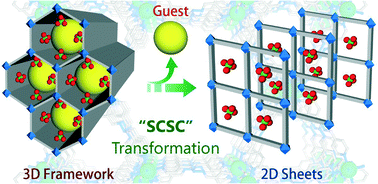
CrystEngComm, 2015,17, 8796-8800
https://doi.org/10.1039/C5CE00139K
Solvent diffusion through a non-porous crystal ‘caught in the act’ and related single-crystal-to-single-crystal transformations in a cationic dinuclear Ag(I) complex
A few snapshots of a dynamic solvent diffusion process through a seemingly non-porous crystal of a dinuclear, cyclic Ag(I) complex were revealed. These indicate the complexity of the process, which involves not only relocation of the molecules in the crystal lattice, but also conformational adjustments of the metallocycles in response to solvent uptake/release.

CrystEngComm, 2015,17, 8957-8964
https://doi.org/10.1039/C5CE01348H
A single-crystal-to-single-crystal Diels–Alder reaction with mixed topochemical and topotactic behaviour
During a SCSC solid-state Diels–Alder reaction, voids are created, followed by conformational change and crystal annealing that lead to the formation of new weak interactions.

CrystEngComm, 2015,17, 8933-8945
https://doi.org/10.1039/C5CE01301A
In situ variable-temperature single crystal X-ray diffraction studies of the single-crystal-to-single-crystal dehydration and rehydration of a mixed-ligand 2D zinc metal–organic framework using trimesate and 4,4′-bipyridine-N,N′-dioxide as ligands
A mixed-ligand 2D MOF based on ZnSO4, trimesate and 4,4′-bipyridine-N,N′-dioxide shows reversible loss of uncoordinated and coordinated water molecules.

CrystEngComm, 2015,17, 8946-8956
https://doi.org/10.1039/C5CE01297J
Modulating the microporosity of cobalt phosphonates via positional isomerism of co-linkers
Three isomeric cobalt phosphonates containing flexible bis(imidazol-1-ylmethyl)benzene (bix) co-ligands are reported, the porosity of which are dependent on the positional isomerism of the co-ligands.

CrystEngComm, 2015,17, 8926-8932
https://doi.org/10.1039/C5CE01087J
Supramolecular open-framework architectures based on dicarboxylate H-bond acceptors and polytopic cations with three/four N–H+ donor units
Supramolecular assemblages based on cationic H-donors and anionic H-acceptors have been envisioned to elaborate organic open frameworks.
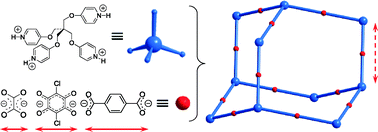
CrystEngComm, 2015,17, 8906-8914
https://doi.org/10.1039/C5CE01070E
Sequential single-crystal-to-single-crystal transformations promoted by gradual thermal dehydration in a porous metavanadate hybrid
The porous hybrid metavanadate [{Cu(cyclam)}(VO3)2]·5H2O undergoes a series of sequential and reversible transformations upon thermally-triggered gradual dehydration that have been monitored by single-crystal X-ray diffraction.

CrystEngComm, 2015,17, 8915-8925
https://doi.org/10.1039/C5CE01076D
Crystalline transformations of dinaphthyridinylamine derivatives with alteration of solid-state emission in response to external stimuli
Dinaphthyridinylamine derivatives were prepared as new fluorophores. Various phase transitions including SC-to-SC, accompanied by vapo-, mechano-, piezo- and thermo-chromism of fluorescence, occurred in response to external stimuli.
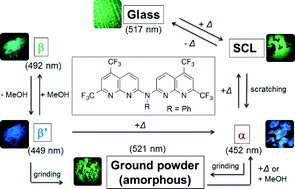
CrystEngComm, 2015,17, 8825-8834
https://doi.org/10.1039/C5CE01126D
Probing the structural changes accompanying a spin crossover transition in a chiral [Fe(II)(N3O2)(CN)2] macrocycle by X-ray crystallography
Single crystals of the chiral macrocycle S,S-[FeII(PhCH2OCH2)2(N3O2)(CN)2] (4) display a gradual spin crossover transition accompanied by a geometrical change of the Fe2 coordination sphere from HS-7 towards LS-6 and a conformational change of the CH2OCH2Ph substituent.
![Graphical abstract: Probing the structural changes accompanying a spin crossover transition in a chiral [Fe(ii)(N3O2)(CN)2] macrocycle by X-ray crystallography](/en/Image/Get?imageInfo.ImageType=GA&imageInfo.ImageIdentifier.ManuscriptID=C5CE01052G&imageInfo.ImageIdentifier.Year=2015)
CrystEngComm, 2015,17, 8897-8905
https://doi.org/10.1039/C5CE01052G
Low temperature phase transition induced biaxial negative thermal expansion of 2,4-dinitroanisole
Thermal behaviour for the two polymorphic forms of 2,4-dinitroanisole (24DNAN) and phase transition of the β-form were studied by variable-temperature single-crystal X-ray diffraction. 24DNAN shows an unusual biaxial NTE after phase transition temperature.
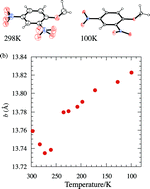
CrystEngComm, 2015,17, 8888-8896
https://doi.org/10.1039/C5CE00029G
Anion triggered and solvent assisted structural diversity and reversible single-crystal-to-single-crystal (SCSC) transformation between 1D and 2D coordination polymers
Synthesis of four new coordination polymers (CPs) 1–4 from angular ditopic ligand 2,6-bis(imidazol-1-yl)pyridine (pyim2) and the anion triggered structural variation (1D and 2D)under different solvent conditions have been reported.

CrystEngComm, 2015,17, 8876-8887
https://doi.org/10.1039/C5CE00690B
Thermally-promoted post-synthetic Pummerer chemistry in a sulfoxide-functionalized metal–organic framework
Simple and accessible conventional thermal heating of a sulfoxide-functionalized zinc metal–organic framework accesses aldehyde groups and increases surface area and porosity in a reagentless single-crystal-to-single-crystal transformation.

CrystEngComm, 2015,17, 8858-8863
https://doi.org/10.1039/C5CE00861A
Reversible single-crystal-to-single-crystal photoisomerization of a silver(I) macropolyhedral borane
A reversible conversion of [trans-B20H18]2− to [iso-B20H18]2− and linkage isomerism occur in a single crystal of {Ag2(PPh3)6[B20H18]} (the positions of [Ag(PPh3)3]+ are shown in red and blue).

CrystEngComm, 2015,17, 8870-8875
https://doi.org/10.1039/C5CE00859J
A topotactic transition in a liquid crystal compound
The title compound has two crystal phases related by an enantiotropic single-crystal-to-single-crystal transition and a nematic liquid crystalline phase before transition to the isotropic liquid phase.

CrystEngComm, 2015,17, 8864-8869
https://doi.org/10.1039/C5CE00660K
Reversible solid to solid transformation in a crystalline state gas–solid reaction under ambient conditions: Fe–N(pyridine) bond formation at the expense of Fe–OH2 bond breaking and vice versa
The non-porous crystalline state of a trinuclear iron cluster containing compound [Fe3(μ3-O)(μ2-CH3COO)6(C5H5NO)2(H2O)]ClO4·3H2O (1) demonstrates a series of crystalline state reactions that can be stimulated by an external substrate, such as methanol or pyridine.

CrystEngComm, 2015,17, 8850-8857
https://doi.org/10.1039/C5CE00488H
Mechanics of twisted hippuric acid crystals untwisting as they grow
Spontaneous twisting of single crystals is a common growth induced deformation.

CrystEngComm, 2015,17, 8817-8824
https://doi.org/10.1039/C5CE00195A
Guest-containing supramolecular isomers of silver(I) 3,5-dialkyl-1,2,4-triazolates: syntheses, structures, and structural transformation behaviours
Using benzene as a template, a series of guest-containing silver(I) 3,5-dialkyl-1,2,4-triazolate isomers showing different structural transformation behaviours have been synthesized.
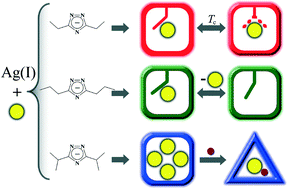
CrystEngComm, 2015,17, 8843-8849
https://doi.org/10.1039/C5CE00004A
Chemical reaction method for growing photomechanical organic microcrystals
Slow mixing of random shaped microcrystals of a tert-butyl ester derivative in the presence of H3PO4/ SDS yields size-uniform microcrystals of the carboxylic acid with unique photomechanical properties
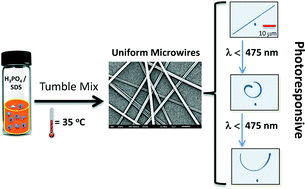
CrystEngComm, 2015,17, 8835-8842
https://doi.org/10.1039/C4CE02387K
About this collection
Guest Edited by Professor Parimal K. Bharadwaj (Indian Institute of Technology, Kanpur) and Professor Panče Naumov (New York University Abu Dhabi), this issue focuses on processes where the long-range structures of single crystals are retained, including: photochemical reactions, solid-solid reactions, solid-gas reactions and phase transitions.